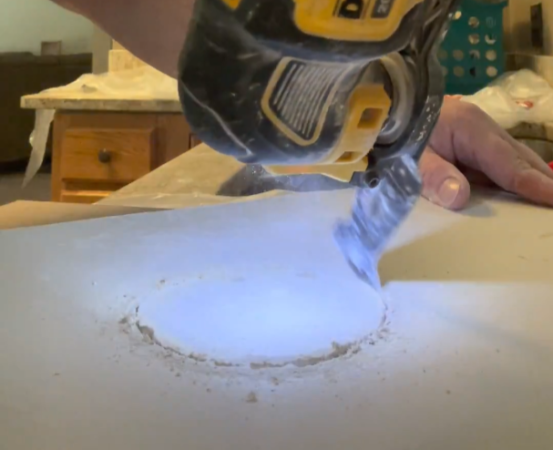Four Ways On How To Cut Drywall So You Get It Right
How To Cut Drywall Like A Pro

This article is for anyone new to the trade and wants to learn how to cut drywall. Interior construction has come a long way, and it’s now easier than ever to work with (thanks to drywall). I know that is debatable; a lot of people consider drywall an art that requires a lot of attention to detail. But really, the installation and cutting of drywall don’t require too much skill to make it work.
If you have never heard of Drywall Central before – I write articles to help others with drywall in my spare time. I’m a full-time drywaller and I do it for a living. I install, tape, mud, finish, sand, and paint drywall. My goal is to help anyone to learn the trade. Also, a big shout out to you – for taking the time to research before just winging it. I’m going to help it be as easy as possible for you.
How Is Drywall Made?
In order to understand why we cut drywall the way we do, I want to first go in-depth into what drywall is and how it’s made. Drywall is composed of mainly calcium sulfate dihydrate (aka gypsum), which is essentially a calcium salt with a hydrate (water). Gypsum is a mineral found naturally, it is a soft rock. Drywall industries will remove all of the moisture from mined gypsum rocks and then grind it up into a fine powder, called stucco.
Once the gypsum is made into a fine powder, it is then mixed with chemical additives, as well as a chemical soap. The soap creates air bubbles within the gypsum to make it lighter. Next, drywall manufacturers will mix this compound with an accelerator so it will be able to dry quicker. This “slurry” mixture will then be placed into a machine to be sandwiched between two large pieces of paper and then dried.
The white paper is the face of the drywall – the thinner paper which will later be mudded and taped. The brown paper is the back of the drywall and it is slightly thicker. In the drywall plant, the drywall is made as a large continuous sheet of drywall, until it is cut precisely to size.
Takeaways:
Drywall is made from a naturally occurring mineral; gypsum.
Gypsum is a soft rock.
It is ground up and mixed with water and soap to make the gypsum lightweight.
How easy is it to cut drywall?
Since we now know how drywall is made, you can understand that in gypsum’s natural form it will be very hard to cut. It comes from a rock. However, thanks to the drywall industry’s innovation, they have made it incredibly easy to cut.
What tools should I use to cut drywall?
Because drywall is so easy to cut, you can use many things to cut it. However, I’m only going to go over the main tools you should be using so it looks like you know what you’re doing. Will a steak knife cut drywall? Yep. But you’ll probably be turning heads. Here are the main tools you should use to cut drywall:
#1 A Sheetrock Knife/Box Cutter
I put these two together because they are more or less the same thing. A sheetrock knife is used by drywallers to “score” the paper face of the drywall for a precise cut.
#2 Oscillating Multi-Tool
An oscillating multi-tool is not a must-have by any means. It is more of a convenient tool to have since it is battery or power-operated to make cuts easy. I typically use a multi-tool not to cut my initial lines, but to trim off areas around outside corners so they are straighter.
#3 Drywall Hand Saw
A drywall hand saw is also known as a jab saw. It is made to cut drywall all the way through, back, and front if you ever need to remove an area of drywall.
#4 Drywall Cutout tool
A drywall cutout tool is a newer cutting tool that utilizes a drill bit with a guide point to cut through drywall. I typically use a drywall cut-out tool around electrical boxes, since the guide-point tip is made to avoid cutting things behind the drywall.
How To Cut Drywall Using A Sheetrock Knife
Using a sheetrock knife is the easiest, most effective, and cleanest way to cut brand new drywall. I do not recommend using a sheetrock knife to cut out an existing area that will need a patch. To cut drywall using a sheetrock knife, first, make sure you have a sharp blade and protection in case of any slips. You will need to mark your line on the drywall using either a 4-foot level, a T square, or a chalk line. When you have your measurements, all you need to do is score the white paper face of the line you created.
Once you have the paper-face scored with your cut, you can snap the drywall to break on that line. When I am working with fresh drywall, I will hold the drywall to the left and right of the cut, then use my knee to slightly hit the brown paper side of the drywall. This will cause the gypsum to snap on the weakest point (which you created by scoring the drywall.)
How To Cut Drywall Using An Oscillating Multi-Tool
An oscillating tool is a great option for cutting drywall if you need access to plumbing or electrical. I mostly use an oscillating multi-tool for squaring off an area that will need a patch. Squaring off any dents or holes in drywall makes it much easier to work with. The downside of an oscillating multi-tool is the amount of dust it creates, so wearing a mask and protecting the floors is a great idea before you begin.
To use an oscillating tool, you should first mark your line for the desired cut with a pencil. The oscillating tool should have a blade that is rated for drywall cutting. When you are ready, you will pull the trigger of the oscillator and make the cuts through the drywall with the flat blade. The main difference with an oscillating tool is that you can easily cut through the depth of the drywall – which is usually only ½” or ⅝”.
How To Cut Drywall With A Drywall Handsaw (Jabsaw)
The drywall handsaw is just like any other handsaw, except this has a fine point to be able to poke through the depth of drywall. It’s best for cutting drywall that is between studs. The drywall handsaw is not made to go through the wood. So if you have a larger area that needs to be cut, I would recommend the oscillating tool instead.
To use a drywall handsaw, first mark the area you would like to cut through. Next, you will pick a starting point, and poke the tip of the saw through the drywall. Applying slight pressure toward the line you created, you will move the saw back and forth to cut through the drywall. If it feels like you have hit something other than drywall – stop immediately. You could be hitting plumbing, electrical, or a stud.
How To Cut Drywall With A Drywall Cutout Tool
A drywall cutout tool is a great option for cutting drywall around circular or rectangular electric boxes. With this tool, you can easily adjust the depth which you would like to cut. It utilizes a drill bit with a smooth tip (aka guide point tip) to avoid cutting through electrical boxes. This is my go-to when it comes to cutting out holes for recessed lighting or cutting holes for light switches and outlets.
Before you begin using a drywall cutout tool, you should first adjust the depth of the cut. The adjustment is done not with the bit, but with the circular guide around the drill bit. I usually keep my depth set at ½” since that is the standard drywall size. Mark your area/hole that needs to be cut with a pencil, and then poke the drill bit tip through it. Now you will hold the drill tight and turn it on. Sometimes this tool requires a bit of force to keep it from wandering off cut, but once you master this tool you’ll be glad you learned!
Conclusion
There are four main methods you can use to cut drywall; a sheetrock knife, an oscillating tool, a drywall hand saw, or a drywall cutout tool. I went through each to help you understand their best uses depending on the drywall cut you need to make. If you found this article helpful, let me know in the comments below! I’d love to hear from you. Let me know what project you are cutting drywall for and which drywall cutting tool you decided to use!



